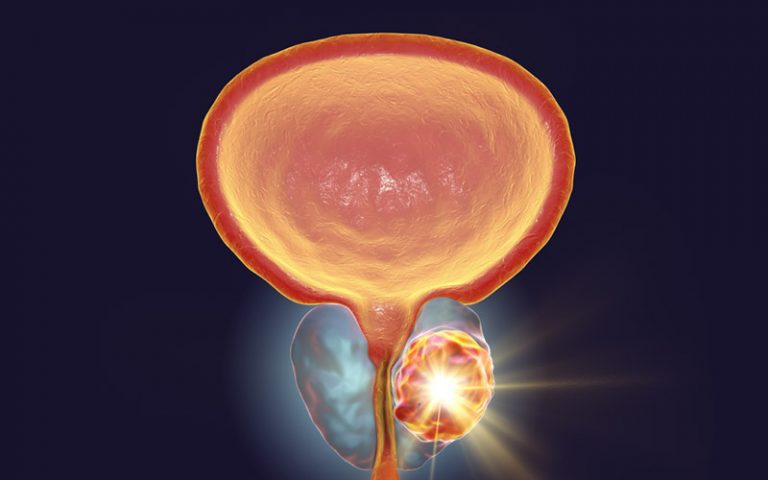
Prostate cancer occurs in a man’s prostate gland and is the second most common type of cancer in men. Prostate cancer that’s detected early has a good chance of successful treatment. It is important for men to get their prostate checked regularly for early detection.
Many types of prostate cancer are slow-growing and may not need treatment. Although prostate cancer can be serious, most men diagnosed with prostate cancer will not die.
Our urologists at Urology Clinics of North Texas will address your concerns and develop a customized treatment plan to treat your prostate cancer while maintaining your health.

There are no known causes for prostate cancer, although there are risk factors that make the disease more likely for some men.
Risk factors for prostate cancer include:
- Age (Begin screening at 45 or 40 if at increased risk due to family history, ethnicity, or known genetic mutations.)
- African American ethnicity
- Family history
- Obesity

Many men have no signs or symptoms of prostate cancer. Prostate cancer is typically found as a result of high prostate-specific antigen (PSA) levels in a blood test or as the result of a digital rectal exam. If PSA levels are high, a biopsy will remove a small piece of tissue from the prostate. If prostate cancer is detected from biopsy, a Gleason score is determined by looking at the biopsy under the microscope and will judge how likely the cancer is to spread.
Screening with PSA should begin at the age of 45 or at 40 if at increased risk, such as family history, African American ethnicity, or known genetic mutations.
Symptoms of prostate cancer can include:
- Erectile dysfunction
- Painful urination
- Discomfort in the pelvic area
- Decreased urine stream

Common treatments for prostate cancer include:
- Active surveillance
- Some forms of prostate cancer are slow-growing and can be closely monitored without any other treatment necessary.
- Surgery
- Some patients are candidates for a prostatectomy, where the prostate is surgically removed.
- Radiation therapy
- External beam therapy is the most common type of radiation therapy. CT scans and MRIs are used to determine the location of the tumor cells in order to create a personalized radiation plan for you.
- Hormone therapy
- Testosterone is the main fuel for prostate cancer growth. Hormone therapy is designed to control prostate cancer growth by lowering testosterone levels. Hormone therapy is often given with radiation therapy.
It is recommended to get your PSA levels checked annually to catch prostate cancer at the earliest stages.


Prostate cancer occurs in a man’s prostate gland and is the second most common type of cancer in men. Prostate cancer that’s detected early has a good chance of successful treatment. It is important for men to get their prostate checked regularly for early detection.
Many types of prostate cancer are slow-growing and may not need treatment. Although prostate cancer can be serious, most men diagnosed with prostate cancer will not die.
Our urologists at Urology Clinics of North Texas will address your concerns and develop a customized treatment plan to treat your prostate cancer while maintaining your health.

There are no known causes for prostate cancer, although there are risk factors that make the disease more likely for some men.
Risk factors for prostate cancer include:
- Age (Begin screening at 45 or 40 if at increased risk due to family history, ethnicity, or known genetic mutations.)
- African American ethnicity
- Family history
- Obesity

Many men have no signs or symptoms of prostate cancer. Prostate cancer is typically found as a result of high prostate-specific antigen (PSA) levels in a blood test or as the result of a digital rectal exam. If PSA levels are high, a biopsy will remove a small piece of tissue from the prostate. If prostate cancer is detected from biopsy, a Gleason score is determined by looking at the biopsy under the microscope and will judge how likely the cancer is to spread.
Screening with PSA should begin at the age of 45 or at 40 if at increased risk, such as family history, African American ethnicity, or known genetic mutations.
Symptoms of prostate cancer can include:
- Erectile dysfunction
- Painful urination
- Discomfort in the pelvic area
- Decreased urine stream

Common treatments for prostate cancer include:
- Active surveillance
- Some forms of prostate cancer are slow-growing and can be closely monitored without any other treatment necessary.
- Surgery
- Some patients are candidates for a prostatectomy, where the prostate is surgically removed.
- Radiation therapy
- External beam therapy is the most common type of radiation therapy. CT scans and MRIs are used to determine the location of the tumor cells in order to create a personalized radiation plan for you.
- Hormone therapy
- Testosterone is the main fuel for prostate cancer growth. Hormone therapy is designed to control prostate cancer growth by lowering testosterone levels. Hormone therapy is often given with radiation therapy.
It is recommended to get your PSA levels checked annually to catch prostate cancer at the earliest stages.

